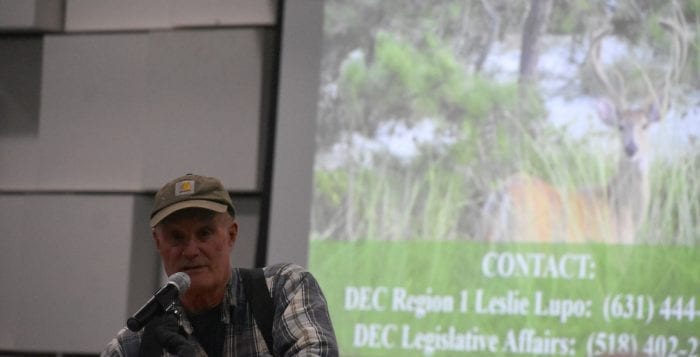Brookhaven Residents Say Town Needs to Do More on Deer Issue

With villages like Belle Terre and Port Jefferson taking steps in handling the issue of deer in their municipalities, Town of Brookhaven representatives say there’s things they can do at the Town level to stop the scourge of deer and their impact on the local environment.
At a forum hosted by Valerie Cartright (D-Port Jefferson Station) and representatives of the New York State Department of Environmental Conservation, residents were split on how to handle the overwhelming deer population, but no one questioned whether their impact has been felt far and wide, whether it’s from them simply eating people’s gardens or the mass depletion of saplings and bushes in Long Island forests.

“We have not played an active role in respect to deer management,” Cartright said. “It is an issue within our Town, and we can’t rely solely on our villages. So, it’s a question of how can we work with the villages, or how we can do something on our own.”
Leslie Lupo, a big game wildlife biologist for the DEC, said that, despite some misconceptions, deer do very well living in a suburban landscape such as Long Island, especially since they have no natural predators. They are polygamous and have short gestation periods, which means, unchecked, their population continues to grow.
“No management means more and more deer,” Lupo said.
Despite residents’ constant complaints of deer eating plants and vegetables at people’s homes and gardens, deer have had an even more major impact on Long Island’s forests and biodiversity, the biologist said. Many of the saplings in forests have been eaten by deer, and their favoring of ground plants has meant the loss of habitat for some songbird species.
“They are a huge changer of their own habitat,” she added. “Deer will just eat everything here and move on to the next property.”
Cartright said the forum was an example of one of the first steps the DEC provides in its deer management guide, originally published in 2012, in starting to make change. Over the last several years, the deer issue has ballooned into near-crisis proportions. While state officials said they cannot give estimates of the number of deer on Long Island, due to migration and other mitigating factors, the total number of deer shot and tagged by hunters in Suffolk County is around 3,200-3,400 in the last five years.
Multiple North Shore villages have gotten ahead of towns in dealing directly with the deer issue. Belle Terre, for example, has been allowing residents to bring in hunters onto their properties as long as they conform to state laws regarding setbacks from other properties. Belle Terre Mayor Bob Sandak said this has already made a significant impact in the village’s deer population.
What More Can Be Done?
With the need to reduce deer population clear, the two major schools of thoughts are to either encourage recreational hunting or professional culls or by surgical or chemical sterilization. Lupo favored hunting, citing mixed-at-best results from sterilization initiatives.
Lupo called recreational hunting the most utilized tool for the DEC and said it is “safe and effective” with a large bowhunting culture on Long Island. Even with nonlethal alternatives, she suggested it would be more effective combined with lethal removal.
Both Lupo and several hunters who came to the Jan. 30 meeting said, despite areas which have been opened up with cooperative agreements with the DEC, there are many parts of the Island where they are restricted from hunting.
Not all municipal lands allow access. While the setback for bowhunters between properties was changed from 500 feet in 2012 to 150 feet a few years later, hunters said there are only a few public properties on which they can actually hunt. The archery season, which runs from Oct. 1 through Jan. 31, is much longer than the shotgun season, which only runs from Jan. 4 to Jan. 31 and requires a Town permit or landowner consent form. The DEC’s tagging system essentially allows for “an unlimited harvest of deer,” Lupo said. “The harvest has been increasing and increasing to go along with our increased population.”
Though DEC officials said some harvest years are better than others, and some are worse than others since various conditions can impact harvest rates, such as weather.
 John German, of the Brookhaven hamlet and an avid hunter, said that, despite there being a large hunting crowd, the number of deer does not seem to have stymied. He and other hunters complained about Town-owned lands in which they are unable to hunt.
John German, of the Brookhaven hamlet and an avid hunter, said that, despite there being a large hunting crowd, the number of deer does not seem to have stymied. He and other hunters complained about Town-owned lands in which they are unable to hunt.
“There’s more deer now than there ever was,” German said.
Some called for the Town when it buys land for municipal purposes to allow hunters on that property, but Cartright said the majority of space the Town acquires is small and not conducive to hunting.
Lupo said that residents or the Town could start organizing hunts and allow residents to interact with them to allay fears, but other residents strongly supported sterilization initiatives, including Elaine Maas, a board member of the Four Harbors Audubon Society, who pointed to data from Hastings-on-Hudson and its chemical contraceptive program, which from 2014 to 2018 sterilized about 60 deer, which the city described as about 75 percent of the population.
Maas also said she has had issues with hunters on a neighboring property for years and described being “confined” in her own home during hunting season.
Surgical sterilization can cost as much as $1,000 per deer, while chemical sterilization can cost anywhere from $500 to $3,000. At minimum, 75-90 percent of females would need to be treated to see some effect. Lupo also said another issue is that, in an uncontrolled setting, deer often migrate to and away from some areas, meaning that some chemical sterilization techniques that require multiple treatments become that much harder.
“Maybe it will prove to be more beneficial in the future,” she said.
Cartright said the next step is to get the rest of the Town council on board. While the board could form a committee in the future, there’s a few “low hanging fruit,” including doing a survey and speaking with villages and her fellow board members. She also mentioned changing Town code regarding fencing to make more residents able to buy higher barriers on property.
This post has been amended Feb. 13 to correct Lupo’s comment on managing deer, also to change “incubation period” to “gestation period” and add context to another of Lupo’s quotes.






